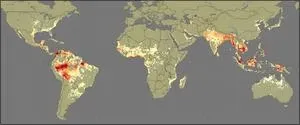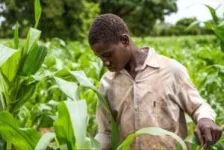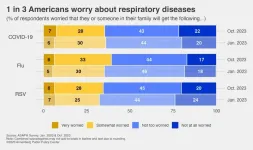(Press-News.org) A global study of major crops has found that farmworkers are being increasingly exposed to combinations of extreme heat and humidity during planting and harvest seasons that can make it hard for them to function. Such conditions have nearly doubled across the world since 1979, the authors report, a trend that could eventually hinder cultivation. The most affected crop is rice, the world’s number one staple, followed closely by maize. As temperatures rise, the trend has accelerated in recent years, with some regions seeing 15-day per-decade increases in extreme humid heat during cultivation seasons.
The study appears today in the journal Environmental Research Communications.
“If this affects humans’ ability to grow food, that’s serious,” said lead author Connor Diaz, who did the research as a Columbia University undergraduate student with scientists at the university’s Lamont-Doherty Earth Observatory. “The global food chain is all connected, and the danger is, this will impact crop production.”
Higher temperatures alone are oppressive, but high relative humidity greatly increases the effects. We cool our bodies by expelling sweat, which contains excess body heat; then, when the sweat evaporates, that heat is carried away. But the more the air is laden with moisture, the less efficiently evaporation can take place—the reason muggy days feel so bad. High humidity is especially prevalent in major tropical and subtropical crop regions in river deltas and near coasts, which supply plenty of moisture for the air to soak up.
Multiple recent studies have already documented increases in extreme combinations of heat and humidity across the world. A 2021 study by Columbia scientists found that the number of city dwellers exposed to extreme humid heat has tripled since the 1980s, affecting more than a fifth of the world population. A 2020 study also out of Columbia found that potentially fatal heat-humidity combinations previously not predicted to appear until mid-century are already popping up in many areas. The new study is the first to look at the effects on farmworkers specifically during cultivation seasons.
Combined heat and humidity are gauged on the “wet bulb” scale, which factors in air temperature, water-vapor content and wind conditions. The authors of the new study define 27 degrees Centigrade wet-bulb as the point where farmworkers will begin struggling. Depending on the exact combination of conditions, this would be equivalent to between 86 and 105 degrees F on “real feel” heat indexes used by popular media.
Some earlier studies have defined 30C wet bulb—roughly 106F or more “real feel”—as extreme for everyday tasks, but farmworkers toiling under direct sun many hours a day may crumble well before that.
The new study found that many major agricultural regions already experience three months of 27C conditions or worse during the year as a whole. These include the Amazon, northern Colombia and parts of Mexico; the coasts of the Red Sea and Persian Gulf; southeast Asia; and much of Malaysia and Indonesia. Countries that see two months or more include Senegal, Ivory Coast, Nigeria, Cameroon and the northern region of Australia.
On shorter time scales, during the crucial planting and harvest seasons, close to half of the world’s rice cropland is already subject to extreme conditions at some point each year, according to the study. For maize the number is about a third. (That rice is more affected is not a surprise, said Diaz; it is generally grown in water-saturated conditions in already hot climates, while maize is often raised in drier, more northerly regions.)
For rice, the highest farmworker exposure is in Bangladesh, with more than 60 days of high humid heat during cultivation seasons. Other regions with high exposure include Vietnam’s Mekong Delta, Myanmar’s Irawaddy Delta, much of Indonesia and Malaysia, parts of coastal Mexico, and the Amazon. For the maize seasons, the highest potential worker exposure encompasses much of Pakistan, the Mekong Delta, northern Colombia, Venezuela, the Philippines, and parts of coastal Mexico and coastal Iran.
The researchers identified 10 other major crops affected to lesser but significant extents, including sorghum, soybeans, potatoes, millet and yams.
“In places like the Amazon, these conditions are already common, and sadly, people have adapted to it, because they have to,” said study coauthor Mingfang Ting, a climate scientist at Lamont-Doherty. She noted that areas with the worst heat and humidity tend to be the same ones where conditions are worsening the fastest. If the same rates of increase continue in coming decades, she said, people may not be able to cope any longer. “The curve is going up so fast. It’s the trend that really makes it worse,” she said.
So far, the bulk of research on the future effects of climate change on food production has focused on the crops themselves, especially the results of dry heat and drought. But a 2021 paper led by Purdue University predicts that if average global temperatures go up by 3 degrees C—which some scientists think may happen this century—it would reduce agricultural laborers’ work capacity by 30% to 50% and lead to substantial increases in food prices. That study does not explicitly take in the added effects of high humidity.
Another recent paper looking at heat risk to the over 1 million hired agricultural workers in the United States found that they are already 20 times more likely to die of illnesses related to heat stress than U.S. civilian workers overall. Apart from the nature of their work, their risks are compounded by poverty and lack of access to health care, the study says—conditions that are common in many of the areas covered by the new heat and humidity study.
The most common means of adapting to rising temperatures in the U.S. and most other countries has been to shift work hours into the night. Allowing workers to reduce their pace and effort, and increasing break times can also help, and some U.S. states and countries such as Spain have mandated such measures. But these efforts reduce worker productivity, which may feed into higher food prices. And fancier adaptations, like air-conditioned retreat spaces and air-conditioned tractors are simply not feasible in much of the world.
“The issue of heat and humidity takes on a whole new dimension when you think about someone who has to work outside all day long under the sun,” said Diaz. Many receive a piecework rate, or are simply trying to raise enough to subsist on, he points out. “That kind of incentive pushes people to work harder and longer than is safe, and people will pay,” he said.
# # #
Scientist contacts:
Connor Diaz cdd2131@columbia.edu
Mingfang Ting ting@ldeo.columbia.edu
More information:
Kevin Krajick, Senior editor, science news, Columbia Climate School/Lamont-Doherty Earth Observatory
kkrajick@ei.columbia.edu 917-361-7766
END
Young Voices Unheard: Children’s Views from Scotland and Greece on Education is a new book published by Bentham Science that attempts to explore the question of how young children view the concepts of Children’s rights.
Giving children an opportunity to voice their ideas on their education is necessary, if we do not want to deprive children of their right to be consulted and their opinions to be listened to and be seriously considered when decisions are made affecting children’s lives (article 12 of the Convention).
The book attempts to give a voice to children aged 5 to ...
In a world driven by digital transformation, Amazon Web Services (AWS) has emerged as a powerhouse, providing on-demand cloud computing platforms and APIs to individuals, companies, and governments. Bentham Science is delighted to unveil "Amazon Web Services: The Definitive Guide for Beginners and Advanced Users," a comprehensive text that simplifies the complexities of AWS, making it accessible to graduate students, professionals, and academic researchers in computer science, engineering, and information technology.
Key Features:
Hands-On Approach for Beginners: The book adopts a practical, hands-on approach, ensuring that beginners can dive into AWS ...
In a paper published Nov. 10 in Intelligent Computing, Philip Nicholas Johnson-Laird of Princeton University and Marco Ragni of Chemnitz University of Technology propose a novel alternative to the Turing test, a milestone test developed by computing pioneer Alan Turing. The paper suggests that it is time to shift the focus from whether a machine can mimic human responses to a more fundamental question: "Does a program reason in the way that humans reason?"
The Turing test, which has long been a cornerstone of AI evaluation, involves a human evaluator attempting to distinguish between human and machine ...
Falls are the leading cause of both fatal and nonfatal injuries in the United States for adults ages 65 and older. With 1 in 4 older adults falling annually, 27,000 deaths, 8 million emergency department (ED) visits, and 800,000 hospitalizations have occurred.
Follow-up after an ED-related fall visit is essential to initiate preventive strategies in these patients who are at very high risk for recurrent falls. Currently, it is unclear how frequently follow up occurs and whether preventive strategies are implemented.
Researchers from Florida Atlantic University’s Schmidt College of Medicine and collaborators explored this issue by investigating ...
PHILADELPHIA – Over a third of American adults are worried that they or someone in their family will get the seasonal flu, Covid-19, or RSV (respiratory syncytial virus) in the next three months, according to a new health survey from the Annenberg Public Policy Center (APPC) of the University of Pennsylvania.
Those three viral illnesses made up the “tripledemic” of respiratory illnesses that overwhelmed some health care facilities last winter. Although RSV typically peaks later in the year, this month hospitals in parts of Texas are already seeing emergency ...
Over the past decade, fine dust conditions in Korea have worsened, as perceived by the general public, with an increase in the number of days per year featuring high-concentration fine dust. Additionally, the previous maximum fine-dust concentration level has been surpassed. In response, the Korean government has expanded its financial investment in efforts aimed at addressing fine-dust issues.
Fine dust consists of particles that are too small to be seen with the naked eye. When these particles enter the human body through the skin and respiratory system, they can cause various diseases. According to a survey conducted by the Korea Environment Institute, three in ten people ...
When winter comes to Japan, fishermen in the northern regions set out to capture one of the most anticipated seasonal delicacies: the horsehair crab. Known locally as “kegani” and bearing the scientific name Erimacrus isenbeckii, this species of crustacean is highly sought after throughout the country. To protect the horsehair crab population from overfishing, the Japanese and prefectural governments have implemented various restrictions on their capture. For example, in Hokkaido, where kegani is abundant, capturing females for consumption is strictly prohibited.
To ...
Gambling addiction can increase the risk of long-term sick leave for several years, according to a new study published in Psychological Medicine. Researchers from Karolinska Institutet behind the study point to the need to detect people with gambling addiction in time to avoid financial and health problems.
Gambling addiction is a psychiatric condition characterized by prolonged and problematic gambling that leads to negative financial, health and social consequences. 1.3 percent of the Swedish population, corresponding to 105,000 Swedes, have gambling problems or an increased risk of gambling problems, but the number ...
Proteins that form clumps occur in many difficult-to-treat diseases, such as ALS, Alzheimer’s, and Parkinson's. The mechanisms behind how the proteins interact with each other are difficult to study, but now researchers at Chalmers University of Technology, Sweden, have discovered a new method for capturing many proteins in nano-sized traps. Inside the traps, the proteins can be studied in a way that has not been possible before.
"We believe that our method has great potential to increase the understanding of early and dangerous processes in a number of different diseases and eventually lead to ...
PULLMAN, Wash. – A novel surgical implant developed by Washington State University researchers was able to kill 87% of the bacteria that cause staph infections in laboratory tests, while remaining strong and compatible with surrounding tissue like current implants.
The work, reported in the International Journal of Extreme Manufacturing, could someday lead to better infection control in many common surgeries, such as hip and knee replacements, that are performed daily around the world. Bacterial colonization of the implants is one of the leading causes of their failure and bad outcomes after surgery.
“Infection ...









